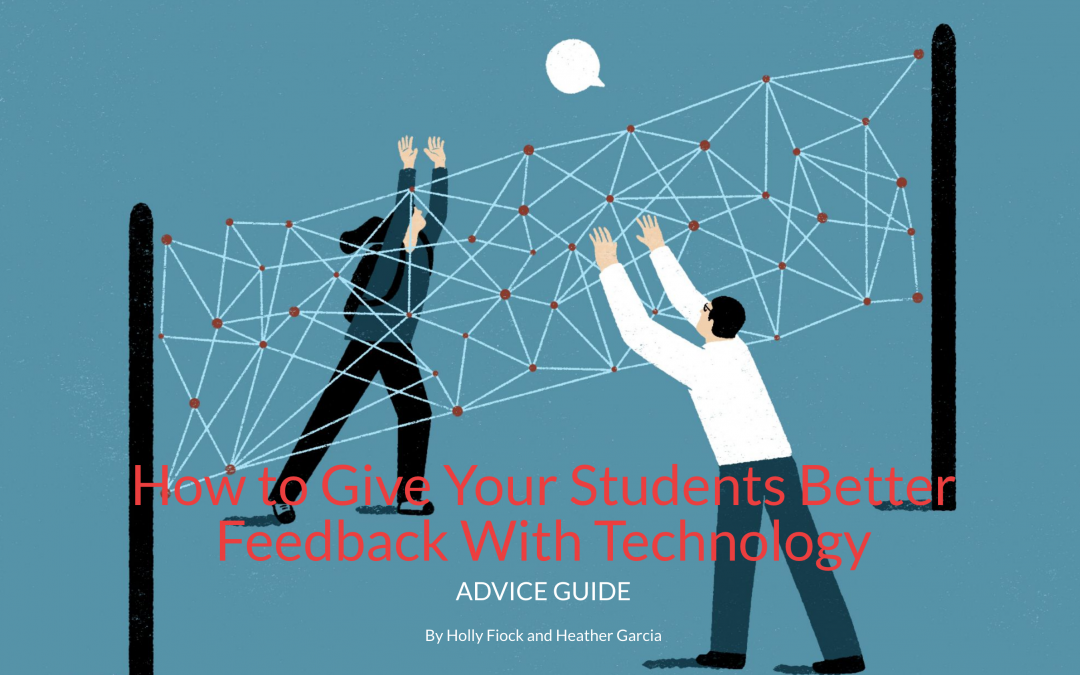Steve Volk (GLCA/GLAA Center for Teaching and Learning and Oberlin College), November 12, 2019
While we typically devote the Feature Article to the research and observations of faculty and staff at one of the GLCA or GLAA campuses, we wanted to diverge a bit here and inform you of a highly useful teaching tool. The Chronicle of Higher Education has just released a highly useful online guide, “How to Give Your Students Better Feedback with Technology.” Written by Holly Fiock (an instructional designer in the College of Education at Purdue University) and Heather Garcia (an instructional design specialist at Oregon State University Ecampus), the guide is divided into eight sections: (1) Essentials; (2) 4 Key Qualities of Good Feedback; (3) 2 Time-Saving Approaches; (4) When to Use Audio or Video Tools for Feedback; (5) When to Stick to Text Feedback; (6) Tips on Getting Started; (7) Common Pitfalls and Smart Solutions; and (8) Resources.
The authors stress that the “goal of any evaluation and feedback should be to support the learning process, help students understand where they did not meet established standards, and aid them in identifying what they can do better next time.” The feedback you provide to your students, therefore, should “guide them toward building new knowledge and increasing their skills.” It should include “specific, detailed directions for future improvement, offered in a manner that is both constructive and encouraging.”
Among the points they offer, the advice on timing – while known to us all – can also prove most difficult if you’re juggling a lot of students overall or a particularly large class. Students certainly want advice sooner rather than later. But when is that? As the authors report, studies tend to show that “the ideal time for learners to receive feedback ranges from two to 15 work days. Beyond that point, students have moved on to other topics and learning activities and the feedback is much less helpful.” I have always found it important to get back an assignment with significant feedback before the students’ next assignment has been handed out.
And this is where technology can come to the rescue, since, once it is mastered, it can be used in a way that can save you some time. The guide provides an introduction to a variety of digital feedback tools that allow instructors to respond to their students’ work, often in a more timely fashion. These include:
- Rubrics: online scoring guides to evaluate students’ work.
- Annotations: notes or comments added digitally to essays and other assignments.
- Audio: a sound file of your voice giving feedback on students’ work.
- Video: a recorded file of you offering feedback either as a “talking head,” a screencast, or a mix of both.
- Peer review: online systems in which students review one another’s work.
In an earlier post, Laurie McMillin (Oberlin) discussed “Using Audio to Comment on Student Papers.” The authors of the Chronicle guide are strong advocates of video and audio feedback, urging “every faculty member to give it a try.” They suggest that screencast videos of a student’s assignment, in which the instructor “walks the student through the project using audio feedback,” can help the instructor connect with each student, providing detailed support specifically tailored to the individual.
If you decide against video or audio feedback, you can still offer text feedback in a digital format, using the annotation tools that are embedded in many course-management systems or built-in rubrics. You can also find digital tools that allow you to copy and save comments from one paper for use on others – although there are obvious disadvantages to this as well (and I caution against simply writing “good job!” on correct answers without further comments as students might not always know what was “good” about the “job” they just turned in).
The Chronicle’s guide provides some useful ways to avoid common pitfalls when using digital means to provide feedback, and its list of resources, consisting of both free and paid tools as well as a “starter kit,” is excellent.
If you don’t have a subscription to the Chronicle and can’t download this resource directly, you should be able to access it through your college or university library’s subscription.
Let us know what you think and whether you have other suggestions for colleagues on providing feedback to students.
The Chronicle’s guide can be found at: https://www.chronicle.com/interactives/20191108-Advice-Feedback

